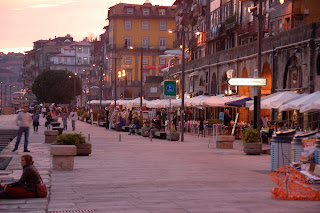View of the Douro River from our apartment and the Ponte Dom Luis I bridge that heads over to the port wine lodges.
View of the Douro upstream. There are six bridges that span this river in Porto and the steel-framed one in the middle of this shot was designed by Gustav Eiffel.
Historically, these boats carried wine from the Douro valley downstream to Porto to make port wine. Now they're mostly for looks along the riverfront.
the Ribeira - basically a riverfront section with restaurants and shops
Sao Bento train station with all of the painted tile murals
Church with more of the blue tile facade.
one of the main strips in Porto........the one that reminded me somewhat of Madrid.
Many of the apartments had their own funky tile designs going on.
For those that aren't port wine officionados like myself...........let me give you a brief rundown. Port wine is not wine. In fact, it's about as close to wine as Miller High Life is to beer (or insert any other favorite crappy beer to rip on in the blanks). It is a medium-sweet wine that packs an alcohol content of about 20%. To make port wine you ferment grapes for only 2-3 days, rather than 10-12 days for normal wines, allowing the natural sugar from the grapes to make alcohol. So if port doesn't ferment for as long as normal wine, why does it have more alcohol (you may be wondering)? The reason is because after 2-3 days a type of grape brandy (more like grappa) called aguardente is added to the wine at a ratio of approximately 4:1, which stops the fermentation of the grapes. This added brandy accounts for the increase in alcohol content, but allows the wine to be sweeter since less of the sugar from the grapes is converted into alcohol. At this point the port is aged for different lengths of time in different sized containers in order to give it the desired flavor. There are many varieties such as tawny, ruby, white, vintage, and late bottle vintage which have different types of grapes and methods of aging. We tried plenty, but it wasn't necessarily my favorite beverage.
Each major producer of port wine has their representative boat kickin' it out here on the Douro.
Inside the storehouse of the "Taylor" port wine lodge. They age this stuff anywhere from 2 years to 40 years! Since they re-use them as much as possible, some of these guys are over 100 years old.
Cue trendy shot of port wine glasses at our tasting.
the tasting room at Taylor's
some of these glasses go for 6 Euros for a little more than a shot, and since I'm cheap I took my time to savor the aged aroma as long as possible.
--Justin












